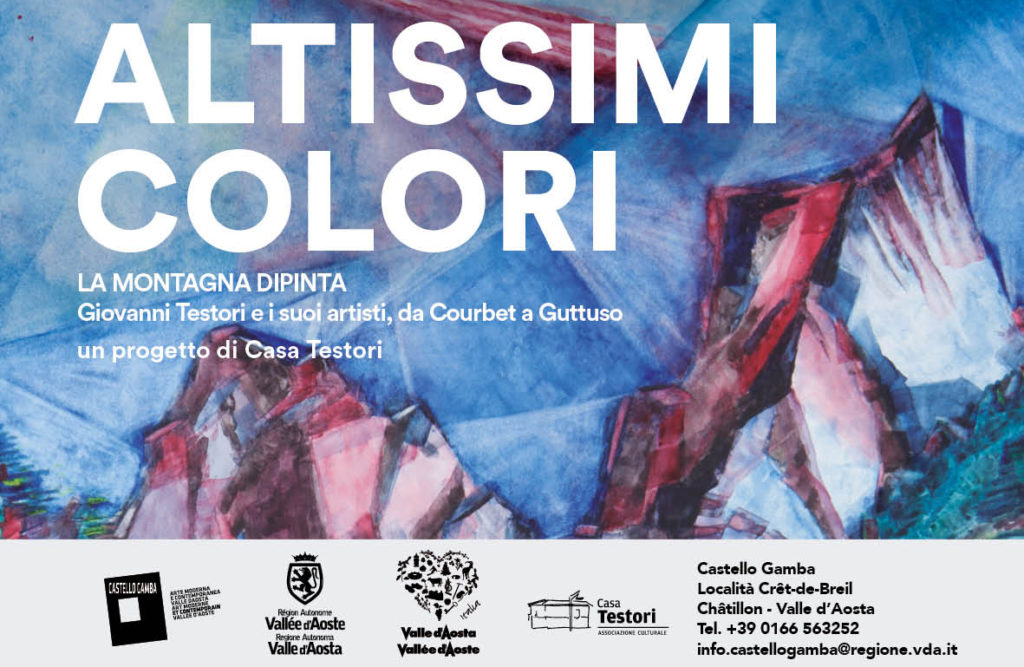ALTISSIMI COLORI. LA MONTAGNA DIPINTA
Giovanni Testori e i suoi artisti, da Courbet a Guttuso
A project by Casa Testori
Curated by Davide dall’Ombra
Castello Gamba – Museo d’arte moderna e contemporanea
Châtillon, Valle d’Aosta
12 July – 29 September 2019

FROM COURBET TO ZIMMER. THROUGH THE EYES OF TESTORI
Davide Dall’Ombra
What does it mean for an artist to experience the mountain and relate it to us?
Giovanni Testori (1923-1993) was one of the most fertile Italian intellectuals of the 20th century, active in many fields of culture, making his mark as painter, writer, poet, dramatist, journalist and art critic. Indeed, Testori is one of the artists present in the collection of Castello Gamba, which conserves his splendid Tramonto [Sunset] (Actus tragicus) of 1967. Visitors are invited to let themselves be transported by Testori’s works and words towards a discovery of the mountain heights. Heights depicted in an exciting array of paintings, heights that dominate the lives of those living among them, and heights experienced and related directly by Testori himself. Testori’s relationship with the mountain, moreover, was not only a leitmotif accompanying his painting, his poetry and his critical writing throughout his life, it marked his debut. His very first article, published in “Via Consolare” in 1941 when he was only 17, was about a painting of a mountain: Giovanni Segantini’s masterpiece, Alpe di maggio [Alpine Pastures in May] (1891), of which Testori published a previously unexhibited preparatory study. It should come as no surprise if his preferred stance of intimate perception also conditioned his outlook as art critic. He remained always ready to extol with his words the paintings of those great artists of the 19th and 20th century which he loved and collected.
The chapter could only open with Gustave Courbet, the revolutionary artist who Testori considered the father of the informal, capable, as no one else could, of rediscovering for us the “mother-matter” of nature. Courbet the artist stands as a sort of manifesto for Testori and for the entire exhibition, not only because he belongs chronologically to the beginning of our journey, but because Testori the critic deemed him the father of all modern painting. Courbet taught all the painters who came after him that matter, not the world of ideas, is the terrain on which pictorial truth is played. Strictly related to Courbet is Paolo Vallorz, an artist from Trento, but Parisian by adoption. Vallorz conserved the teaching of the French master in his pictorial patterns, in which he worked out his unconditional love for the Val di Sole (Trento). It was Vallorz’s extraordinary symbiosis with the life and feelings of the mountain and its people that so enchanted Testori.
Renato Guttuso’s fiery sunsets inevitably enliven the chromatic range of our exhibition. Guttuso was a Sicilian who, bewitched by the sight of Monte Rosa, made his house at Velate, in Varese, into an atelier where he created many of his most famous works. “Guttuso at Varese”, indeed, was the theme of an exhibition strongly promoted by Testori, and which opened with this very pastel: “one of those blazing, besotted farewells; flung onto the paper with dazzling freedom (and yet the substance is that of the pastel, immediate, crumbling and delicate)”. Thus Testori sealed, in 1984, over 40 years’ friendship and collaboration with Guttuso, embracing articles, reviews and introductions to catalogues. Testori dedicated many pages to the painter who, whatever their ideological differences, had been a major interlocutor ever since the passionate years of Italian Realism, during the war and the ensuing years of reconstruction.
Varlin, the talented artist from Zurich who chose to live among the mountains of Val Bondasca, in the Swiss canton of Grisons, close to the Giacometti home in Stampa, is the creator of some of the most extraordinary snow scenes in the history of European art. Works which enthralled Testori, and were decisive for his own commitment to painting. Together with Friedrich Dürrenmatt, Testori was the greatest spokesman for this painter, in whom he found all he was seeking in art: drama – also in the theatrical sense of the word – and the truth of domestic life-patterns. An art that spares no one, where daily life is always exalted to the level of the universal.
We pay homage, lastly, to Bernd Zimmer, the German painter “discovered” by Testori, who fell in love with his views of nature, with his fiery, visionary mountains. Zimmer was a leading exponent of the so-called “Neue Wild”, artists from Berlin who sought fortune in Italy in the 1980s and found one of their most important spokesmen in Testori. The energy released by these artists’ paintings provided a decisive stimulus for Testori in his role of militant critic, committed as he then was to promoting young painters from Italy and beyond. He curated a number of exhibitions on this theme, and reviewed others for the “Corriere della Sera”, the artistic page of which he edited from 1977 until his death.














